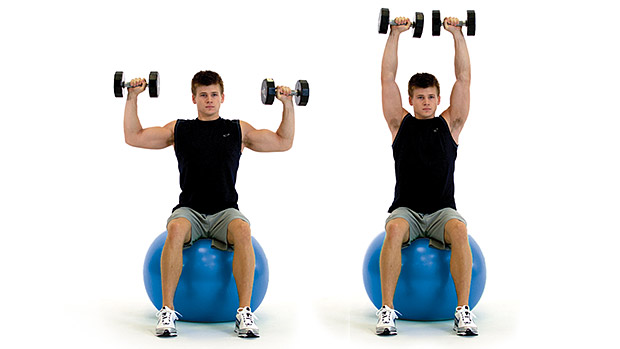Unstable surface training can have its place in the rehab of certain injuries. But using unstable surface training (like kneeling or standing on a stability ball while lifting weights) for improving strength and sports performance is a different story.
A quick summary of the relevant research shows that:
"The diminished force output suggests that the overload stresses required for strength training necessitate the inclusion of resistance training on stable surfaces."
"Resistance exercise performed on unstable equipment may not be effective in developing the type of balance, proprioception, and core stability required for successful sports performance. Free weight exercises performed while standing on a stable surface have been proven most effective for enhancing sports related skills."
So if you want to gain strength and improve power, you must create sufficient overload on the body to stimulate those adaptations. But lifting weights while standing or kneeling on a ball is a misuse of the stability ball because the environment created isn't nearly as effective as being on a stable surface for stimulating gains in strength and power.
Unless you're a Cirque du Soleil performer whose act involves balancing on a big ball, the ground you're living on, practicing on, and playing on is stable.
What About Balance?
Some claim that they're not using stability ball exercises to increase strength, but instead to improve balance. The problem is, using a stability ball is a learned skill that's no different than learning the skill of riding a bike. You get good at riding a bike through practice, just as you get good at standing on a ball through practice. No one expects having the ability to balance on a bike will offer much transfer into improved (functional) performance in non-bike-riding activities.
So it doesn't make sense to think using a stability ball will be any different. It doesn't come close to replicating the force production and neuromuscular coordination patterns of running, jumping, punching, throwing, etc.
Although this may seem logical and based on the principle of specificity, we still have trainers preaching that becoming a trained seal on a ball by standing it on it while performing different resistance exercises will somehow transfer into functional performance in any athletic endeavor.
Believe it or not, the stability ball is one of my favorite training tools because it's cheap, takes up very little space, and offers a wide variety of effective exercise applications that can be used for general fitness, physique, and performance training.
Just because there are people who abuse a certain tool doesn't mean we should throw it out of our training toolbox... if the tool can be used in a way that actually has value. Heck, if that were the case we wouldn't use any equipment at all judging by some of the questionable things I've seen done with barbells, dumbbells, and medicine balls.
The stability ball is like any other training tool: how well it works is determined by the user.
References
- Behm D and Colado JC. The Effectiveness Of Resistance Training Using Unstable Surfaces And Devices For Rehabilitation. Int J Sports Phys Ther. 2012 Apr; 7(2): 226–241.
- Anderson KG, Behm DG. Maintenance of EMG activity and loss of force output with instability. J Strength Cond Res. 2004 Aug;18(3):637-40.
- Willardson, Jeffrey. (2004). The Effectiveness of Resistance Exercises Performed on Unstable Equipment. Strength & Conditioning Journal. 26. 10.1519/00126548-200410000-00015.





